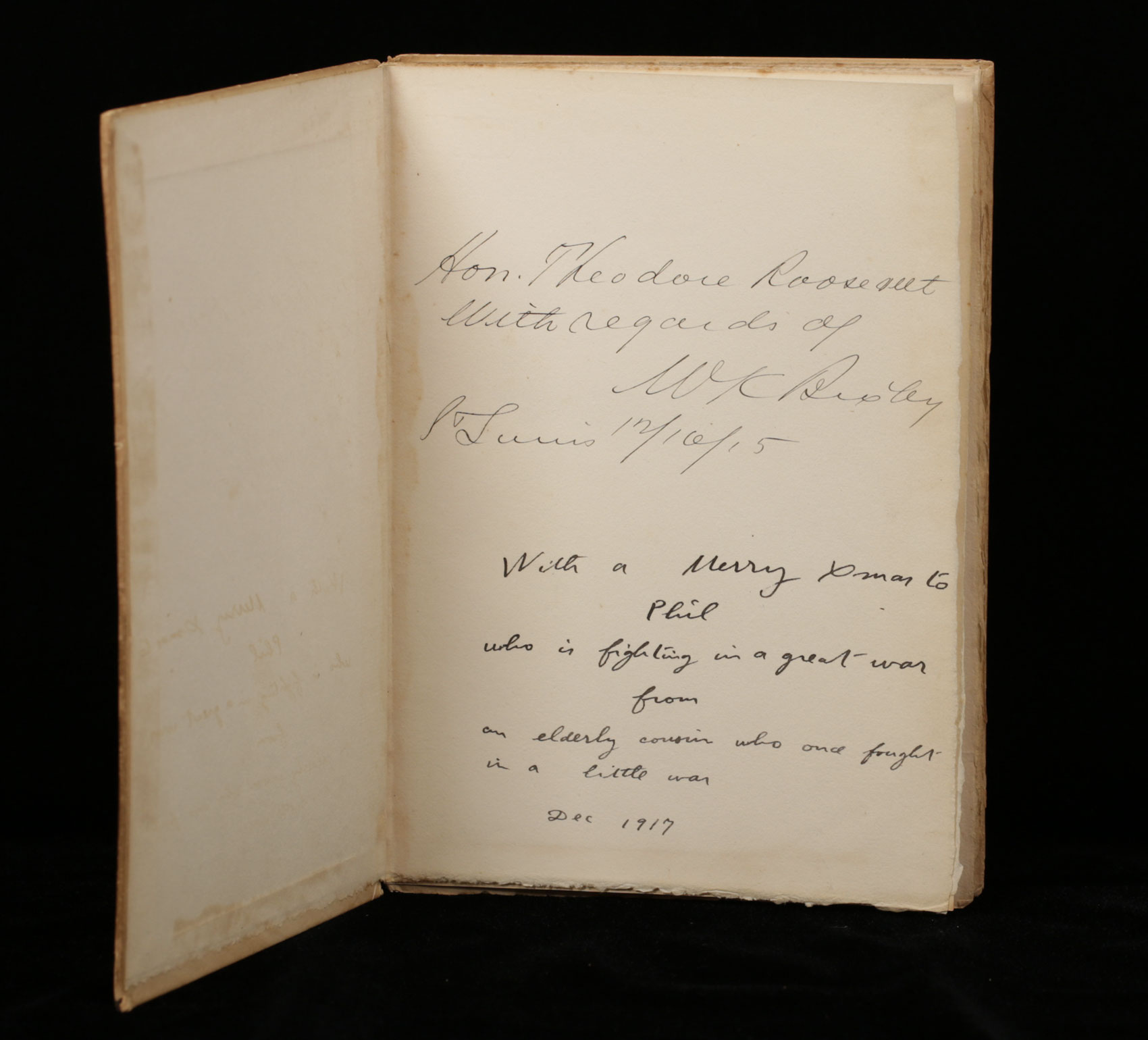A Rare Book From the Library of Theodore Roosevelt; He Compares the Spanish-American War to World War I, Calling the Former a “little war” and the latter a “great war”


Showing his love of military strategy and historical events.
Gifted to a cousin carrying on the Roosevelt tradition, going off to fight in World War I, a war which would claim his son just months later
In 1897, President McKinley appointed Theodore Roosevelt Assistant Secretary of the Navy, and TR found himself in this office when the United States declared war...
Gifted to a cousin carrying on the Roosevelt tradition, going off to fight in World War I, a war which would claim his son just months later
In 1897, President McKinley appointed Theodore Roosevelt Assistant Secretary of the Navy, and TR found himself in this office when the United States declared war on Spain in 1898. Always ready for action, he promptly resigned his post to form a volunteer regiment of western cowboys and eastern adventurers that the press dubbed "Roosevelt's Rough Riders." The Spanish-American War did not last long, but it was long enough for the Rough Riders to take San Juan Hill and pass into folklore. Roosevelt returned to the United States as the most famous man in the nation. Three years later he was President.
Philip Roosevelt was the first cousin once removed of TR and an original member of Raynal Bolling’s 1st Aero Company of the New York National Guard. He did not qualify as a military aviator due to his eyesight, but as a military-aviation journalist he was a prominent aerial warfare expert. Immediately after the U.S. Congress declared war on Germany on April 6, 1917, the Signal Corps summoned Philip to Washington to help plan the aviation mobilization. He impressed Benjamin Delahauf Foulois and accompanied him to France. Philip was instrumental in planning America’s first-ever air-land battle, at a time when the US Army was still learning the nuances of command relationships between the pursuit and observation groups and the corps and armies they supported.
In 1815, Emmanuel de Grouchy, a long time Napoleonic Cavalry Commander, joined Napoleon on his return from Elba, and was made Marshal and peer of France. In the campaign of Waterloo he commanded the reserve cavalry of the Grande Army. After the Battle of Ligny he was appointed to command the right wing. Napoleon sent Grouchy to pursue a part of the retreating Prussian army under the command of General Johann von Thielmann. On 17 June, Grouchy was unable to close with the Prussians. Despite hearing the cannon sound from nearby Waterloo, he decided to follow the Prussians along the route literally specified in his orders while the Prussian and British-Dutch armies united to crush Napoleon. He won a smart victory over the III Prussian Corps in the Battle of Wavre, on 18–19 June 1815, but it was then too late, as by the time this battle was over, Napoleon had already lost at Waterloo.
WK Bixby was a St. Louis collector, philanthropist, and civic leader. He had collected the original manuscript of Grouchy’s account of Waterloo, a manuscript he published as a limited edition and distributed to a handful of people. One of them was Theodore Roosevelt.
"Marshal Grouchy’s Own Account of the Battle of Waterloo", published in late 1815, this is part of a limited edition, and is inscribed by Bixby to “Hon. Theodore Roosevelt with regards of WK Bixby, St. Louis, 12/16/15.” Roosevelt kept this book in his library for 2 years as a great account of battle until his cousin Philip Roosevelt was sent to Europe to participate in World War I. TR here added his own inscription. “With a Merry Xmas to Phil, who is fighting in a great war from an elderly cousin who once fought in a little war, Dec 1917.” This is both a reminiscence of TR's time as a fighting man and a prescient comment about the brutality of the coming war, which would claim one of his children months later.

Frame, Display, Preserve
Each frame is custom constructed, using only proper museum archival materials. This includes:The finest frames, tailored to match the document you have chosen. These can period style, antiqued, gilded, wood, etc. Fabric mats, including silk and satin, as well as museum mat board with hand painted bevels. Attachment of the document to the matting to ensure its protection. This "hinging" is done according to archival standards. Protective "glass," or Tru Vue Optium Acrylic glazing, which is shatter resistant, 99% UV protective, and anti-reflective. You benefit from our decades of experience in designing and creating beautiful, compelling, and protective framed historical documents.
Learn more about our Framing Services








































































































